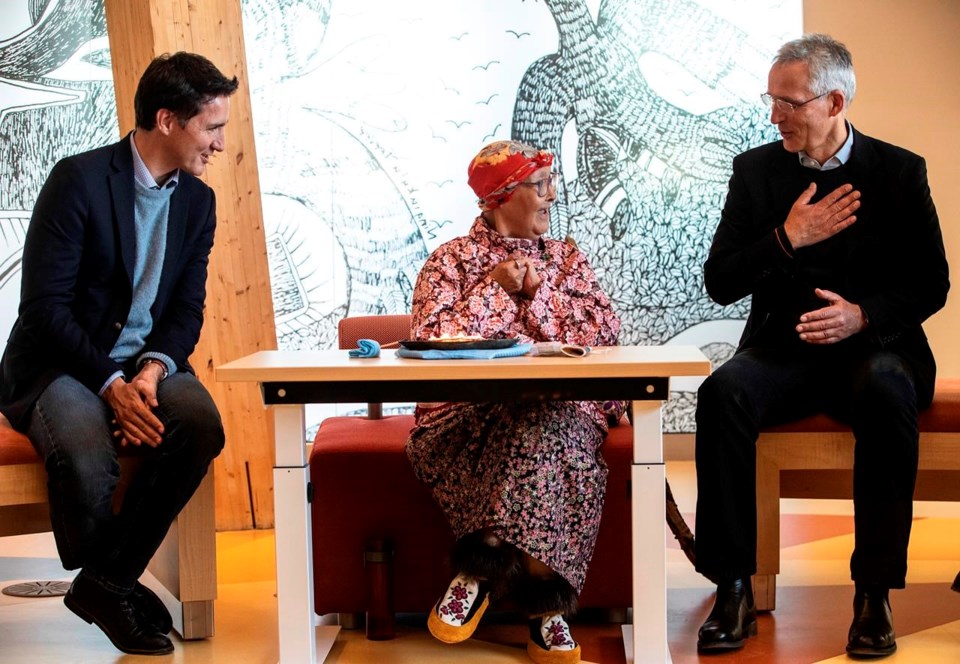COLD LAKE, Alta. — Prime Minister Justin Trudeau wants European allies to know that when Canada invests in defending North America and the Canadian Arctic, they also benefit.
The prime minister directly linked Canada's work alone and with the United States on defending the continent to security in Europe during a news conference on Friday at a Royal Canadian Air Force Base in Cold Lake, Alta.
The event came at the end of a visit by NATO Secretary-General Jens Stoltenberg, during which Trudeau showcased some of the investments and activities that Canada is making at home while also pulling its weight in Europe.
Those include promises to invest billions of dollars in new military equipment and capabilities, including plans to purchase new fighter jets and modernize North America’s aging Norad early-warning system with Washington.
“Canada has recently announced major investments to modernize our Norad capabilities, which will contribute to strengthening NATO’s northern and western flank,” Trudeau said.
The assertion came in the context of current tensions with Russia after its invasion of Ukraine, as well as a growing emphasis on Arctic security as rapidly rising temperatures make the area more accessible – and conflict-prone.
But Trudeau’s comments also coincide with Canada's continued refusal to dramatically increase military spending to meet NATO's target that all members allocate two per cent of their national gross domestic product toward defence.
Canada has long touted its numerous contributions to NATO operations abroad as a better measure of its commitment to the transatlantic military alliance, including the deployment of troops, fighter jets and warships to Europe following the invasion of Ukraine.
But Trudeau suggested allies need to also recognize what Canada is doing closer to home.
“Understanding that Russia is an increasing concern to all of us makes it timely for us to share with the secretary-general and with NATO all the things Canada is doing through Norad, but also independently to make sure we’re protecting this region,” he said.
“We will continue to lead on the defence of North America. But as NATO members, it is, of course, perfectly germane to invite the secretary-general (to Canada) and to highlight the work that we’re doing as NATO members in protecting this region.”
Stoltenberg’s tour included meeting troops in Nunavut participating in the Canadian Armed Forces’ premier Arctic training exercise, as well as seeing one of the military radar sites that forms the backbone of Canada’s contribution to Norad today.
Built in the 1980s to detect a Soviet attack, the radar fixtures are now obsolete thanks to advances in Russian missile technology. The Liberals have promised nearly $5 billion over six years and $40 billion over 20 years to upgrade the entire system with the U.S.
The NATO leader, who also visited a recently opened High Arctic research station in Nunavut before flying to the Cold Lake base, home to one of Canada's two main fighter jet wings, appeared more than ready to accept Trudeau’s message.
“What happens here matters not only for Canada, it matters for the whole alliance,” Stoltenberg said.
“Therefore we strongly welcome what Canada has done in this part of the alliance for decades with Norad, with the radar sites, with defence capabilities including what we see here at the Cold Lake base.”
Yet in a separate interview with The Canadian Press Stoltenberg continued his push for Canada to boost its defence spending to reach the two per cent of GDP mark, which all members first agreed to back in 2014.
“Canada has increased defence spending ... and we welcome that,” he said. “But of course we expect allies to do more. So therefore this is always an issue, and it will continue to be as long as allies don’t meet the two per cent guideline.”
Canada spent 1.32 per cent of its GDP on defence in fiscal year 2021-22, according to a briefing note prepared for Defence Minister Anita Anand in June in anticipation of questions on the topic in the House of Commons.
Not only did that put Canada near the back of the 30-member NATO alliance, but the note projects that spending will top out at 1.59 per cent in 2026-27 — when all members are supposed to be spending two per cent.
The parliamentary budget officer has estimated that in order for Canada to reach the two per cent benchmark, it would need to spend between $13 billion and $18 billion more per year over the next five years.
This report by The Canadian Press was first published Aug. 26, 2022.
— With files from Lee Berthiaume in Ottawa
Bob Weber, The Canadian Press


